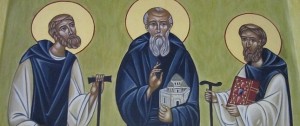 The Church prays at Mass today: O God, who have given us in Saint Frances of Rome a singular model of both married and monastic life, grant us perseverance in your service, that in every circumstance of life we may see and follow you.
The Church prays at Mass today: O God, who have given us in Saint Frances of Rome a singular model of both married and monastic life, grant us perseverance in your service, that in every circumstance of life we may see and follow you.
Here is a portion of Saint Frances’ biography from a life of the saint by Sister Mary Magdalene Anguillaria, superior of the Oblates of the Tor’ de Specchi:
God not only tested the patience of Frances with respect to her material wealth, but, as I have said before and will reiterate, he also tested her own body in a variety of ways, especially through long and serious illnesses which she had to undergo. And yet no one ever observed in her a tendency toward impatience. She never exhibited any displeasure when she complied with an order, no matter how foolish.
Through the premature deaths of her sons whom she loved dearly, Frances proved her constancy. With peace of soul she always reconciled herself to the will of God and gave him thanks for all that happened. With the same constancy she endured the slander of those who abused and reviled her and her way of life. She did not show the least hint of aversion toward them, even though she knew that they judged her rashly and spoke falsely of her way of life. Rather, returning good for evil, she habitually prayed to God for them.
God had not chosen her to be holy merely for her own advantage. Rather, the gifts he conferred upon her were to be for the spiritual and physical advantage of her neighbor. For this reason he made her so lovable that anyone with whom she spoke would immediately feel captivated by love for her and ready to help her in everything she wanted. Divine power was present and working in her words, so that in a few sentences she could bring consolation to the afflicted and the anxious, calm the restless, pacify the angry, reconcile enemies and extinguish long-standing hatreds and animosities. Again and again she would prevent a planned revenge from being carried out. She seemed able to subdue the passions of every type of person with a single word and lead them to do whatever she asked.
For this reason people flocked to Frances from all directions, as to a safe refuge. No one left her without being consoled, although she openly rebuked them for their sins and fearlessly reproved them for what was evil and displeasing to God.
Many different diseases were rampant in Rome. Fatal diseases and plagues were everywhere, but the saint ignored the risk of contagion and displayed the deepest kindness toward the poor and the needy. Here empathy would first bring them to atone for their sins. Then she would help them by her eager care, and urge them lovingly to accept their trials, however difficult, from the hand of God. She would encourage them to endure their sufferings for love of Christ, since he had previously endured so much for them.
Frances was not satisfied with caring for the sick she could bring into her home. She would seek them out in their cottages and in public hospitals, and would refresh their thirst, smooth their beds, and bind their sores. The more disgusting and sickening the stench, the greater was the love and care with which she treated them.
She used to go to the Campo Santo with food and rich delicacies to be distributed to the needy. On her return home she would bring pieces of worn-out clothes and unclean rags which she would wash lovingly and mend carefully, as if they were to be used for God himself. Then she would fold them carefully and perfume them.
For thirty years Frances continued this service to the sick and the stranger. While she was in her husband’s house, she made frequent visits to Saint Mary’s and Saint Cecilia’s hospitals in Trastevere, and to the hospital of the Holy Spirit in Sassia and to a fourth hospital in the Campo Santo. During epidemics like this it was not only difficult to find doctors to care for the body but even priests to provide remedies for the soul. She herself would seek them out and bring them to those who were disposed to receive the sacraments of penance and the Eucharist. In order to have a priest more readily available to assist her in her apostolate, she supported, at her own expense, a priest who would go to the hospitals and visit the sick whom she had designated.
Category: Benedictine saints & blesseds
Saint Peter Damian, Doctor of the Church
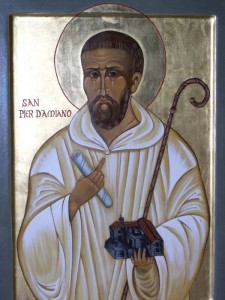 Today is the feast of a great Benedictine monk, bishop and cardinal of the Church. The Mass prayer quotes the Rule of Benedict when it says “putting nothing before Christ” connecting the ministry of Peter with his “ardent in the service of your Church, we may be led to the joys of eternal light.” Peter was a great reformer of the monastic life and the Church. Given the state of the Church today in some places, we need another Peter Damian.
Today is the feast of a great Benedictine monk, bishop and cardinal of the Church. The Mass prayer quotes the Rule of Benedict when it says “putting nothing before Christ” connecting the ministry of Peter with his “ardent in the service of your Church, we may be led to the joys of eternal light.” Peter was a great reformer of the monastic life and the Church. Given the state of the Church today in some places, we need another Peter Damian.
Here is a portion of a letter by Saint Peter Damian:
“Let us rejoice in the joy that follows sadness”
You asked me to write you some words of consolation, my brother. Embittered by so many tribulations, you are seeking some comfort for your soul. You asked me to offer you some soothing suggestions.
But there is no need for me to write. Consolation is already within your reach, if your good sense has not been dulled. My son, come to the service of God. Stand in justice and fear. Prepare your soul; it is about to be tested. These words of Scripture show that you are a son of God and, as such, should take possession of your inheritance. What could be clearer than this exhortation?
Where there is justice as well as fear, adversity will surely test the spirit. But it is not the torment of a slave. Rather it is the discipline of a child by its parent.
Even in the midst of his many sufferings, the holy man Job could say: Whip me, crush me, cut me in slices! And he would always add: This at least would bring me relief, yet my persecutor does not spare me.
But for God’s chosen ones there is great comfort; the torment lasts but a short time. Then God bends down, cradles the fallen figure, whispers words of consolation. With hope in his heart, man picks himself up and walks again toward the glory of happiness in heaven.
Craftsmen exemplify this same practice. By hammering gold, the smith beats out the dross. The sculptor files metal to reveal a shining vein underneath. The potter’s furnace puts vessels to the test. And the fire of suffering tests the mettle of just men. The apostle James echoes this thought: Think it a great joy, dear brothers and sisters, when you stumble onto the many kinds of trials and tribulations.
When men suffer pain for the evil they have perpetrated in life, they should take some reassurance. They also know that for their good deeds undying rewards await them in the life to come.
Therefore, my brother, scorned as you are by men, lashed as it were by God, do not despair. Do not be depressed. Do not let your weakness make you impatient, Instead, let the serenity of your spirit shine through your face. Let the joy of your mind burst forth. Let words of thanks break from your lips.
The way that God deals with men can only be praised. He lashes them in this life to shield them from the eternal lash in the next. He pins people down now; at a later time he will raise them up. He cuts them before healing; he throws them down to raise them anew.
The Scriptures reassure us: let your understanding strengthen your patience. In serenity look forward to the joy that follows sadness. Hope leads you to that joy and love enkindles your zeal. The well-prepared mind forgets the suffering inflicted from without and glides eagerly to what it has contemplated within itself.
Saint Scholastica
 Today’s liturgical feast of Saint Scholastica (480-543) is indeed a special one for all of us who follow and live the Benedictine charism. Scholastica, the twin sister of Benedict was born in Norica (Italy) and some of her bones are entombed with her brother’s at the Archabbey of Montecassino. What we know of Schoalstica comes from a brief entry in a greater work by Pope Saint Gregory the Great, The Dialogues.
Today’s liturgical feast of Saint Scholastica (480-543) is indeed a special one for all of us who follow and live the Benedictine charism. Scholastica, the twin sister of Benedict was born in Norica (Italy) and some of her bones are entombed with her brother’s at the Archabbey of Montecassino. What we know of Schoalstica comes from a brief entry in a greater work by Pope Saint Gregory the Great, The Dialogues.
Sister Catherine gives a keen reflection on the place of Saint Scholastica for us today.
Our thoughts turn to the various Benedictine monasteries in the USA and abroad, especially St Scholastica Priory (Petersham), for the Saint’s intercession.
Saint Scholastica is the patron saint for nuns, but she is asked to stop lightening, rain, and storms. Perhaps she has some influence over stopping snow (for the time being)?
Here is a poetic text honoring Scholastica that is normally set to music by J. Michael Thompson:
Now set me as a seal upon your heart,
And like a seal set me upon your arm,
For love is strong, as strong as mighty death—
No flood can quench nor waters bring it harm.
We give you thanks, O Lord of boundless love,
That you have taken to yourself this day
Scholastica, your bride and lover fair,
Who served in love and followed in your way.
In Bethany with Mary, Martha, too,
You taught while Mary sat and heard your word.
So did Scholastica within her cell;
She listened well and lived out what she heard.
Teach us to love and thus from you obtain
That perfect joy the Holy Rule proclaims.
Teach us to follow you through thorns of life
With hearts of praise, let us your grace acclaim.
O God the Father, all creation’s source,
O God the Son, who died that we might live,
O God the Spirit, font of ev’ry grace,
O Triune God, our thankful hymns we give!
J. Michael Thompson
Copyright © 2010, World Library Publications
10 10 10 10
SURSUM CORDA
Sainted Cistercian founders: Robert Molesme, Stephen Harding and Alberic
From e hymn for evening Vespers for the holy founders of Citeaux:
“Bold leader of this vast array, Saint Robert, intercede today. God grant us hearts to dream anew, and strength his kingdom to pursue.
Fond lover of that hallowed place, where brothers lived as one by grace, Saint Alberic, pray we may be one heart, one mind, in unity.
Impassioned master in Christ’s school, Saint Stephen, zealot for our rule, bid God we never build on sand, but firm in faith, on rock we stand.”
You may be aware that these saints are not honored on the Roman liturgical calendar, but revered by the monks and nuns of the Cistercian and Benedictine monasteries, are the three holy founders of Citeaux (near Dijon, France): Saints Robert Molesme (centered in the image), Stephen Harding and Alberic. They began their reform of Benedictine life in 1098. The Cistercian movement is now venerable but when it was started it was very contentious as you might expect –anytime you ask people to change you run against the tide. Think of the Prophets, or in particular, the Prophet Jonah of yesterday’s reading at Mass. Let us pray for our own conversion, and that of the Church. But also for God’s abundant grace to fall on those who have made profession to the charism of Citeaux –monks, nuns, and the laity.
The early Cistercians, impelled by a burning thirst for authenticity, wished to interpret the Rule (of St. Benedict) in the light of its monastic background and to recover its original simplicity. Their life was marked by a real detachment from the world, a love of solitude and silence, poverty and simplicity, austerity and manual labor, prayer and holy reading, all within a cenobitic framework which laid great stress upon the value of fraternal charity in the common life.
There is an attractive genuinity about this reform, which was not merely an archeologizing return to the past, but a recapturing of the primitive monastic ideal and an attempt, largely successful, to express it in structures suitable to the times.
The school of spirituality which the white monks produced, dominated by St. Bernard, is no less notable for its charming huamanity than for its authentically contemplative orientation.
Monastic Spirituality
Claude Peifer, O.S.B.
Saint Meinrad
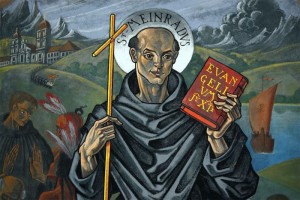 Today, the Benedictine liturgical calendar recalls for us the life and martyrdom of Saint Meinrad (+861) –the Apostle for Hospitality. Meinrad was a Swiss hermit. His life can be read here.
Today, the Benedictine liturgical calendar recalls for us the life and martyrdom of Saint Meinrad (+861) –the Apostle for Hospitality. Meinrad was a Swiss hermit. His life can be read here.
Join me in praying for those whose mission it is to offer hospitality (and who are often wounded in doing so), for the monastic community and oblates of the venerable Archabbey of Saint Meinrad in Indiana.
Luigi Giussani: “God was moved by our nothingness, by our betrayal, by our crude, forgetful and treacherous poverty, by our pettiness. For what reason? “I have loved you with an eternal love, therefore I have made you part of me, having pity on your nothingness.The beat of the heart is pity on your nothingness but the reason why is that you might participate in being.”
Blessed Cyprian Michael Iwene Tansi
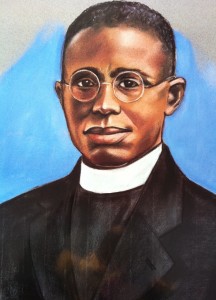 Today is the Feast Day of Blessed Cyprian Michael Iwene Tansi. In the USA we don’t liturgically have Blessed Cyprian on the calendar, but we ought to know about him and follow his example. First a secular priest and then a Trappist monk Tansi has a unique vocation of looking at both the interior life and the apostolate with new eyes. He is Nigeria’s patron saint.
Today is the Feast Day of Blessed Cyprian Michael Iwene Tansi. In the USA we don’t liturgically have Blessed Cyprian on the calendar, but we ought to know about him and follow his example. First a secular priest and then a Trappist monk Tansi has a unique vocation of looking at both the interior life and the apostolate with new eyes. He is Nigeria’s patron saint.
Born to non-Christian parents in September 1903, Blessed Cyprian Michael Iwene Tansi was born in Aguleri, Anambra State, Nigeria. In 1909, he was sent to live with his uncle who was a Christian gave him an education. He was baptised 3 years later by Irish missionaries. Tansi was a diligent student with a precocious personality and deep piety. He worked as a teacher for 3 years and later served as a headmaster of St. Joseph’s school for one year in Aguleri.
In 1925 against the wishes of his family, he entered St. Paul’s Seminary in Igbariam and was ordained a priest in the Cathedral of Onitsha on 19 December 1937.
For a time Tansi worked tirelessly in the parishes of Nnewi, Dunukofia, Akpu/Ajali before discerning vocation to be a Cistercian monk at Mount Saint Bernard Abbey, Leicester, England. He lived this vocation at the abbey for 14 years. He was in the process of discerning becoming the novice master in a new Cistercian foundation in Cameroon, a few months after the founders left for Africa.
Father Tansi used to say, “if you are going to be a Christian at all, you might as well live entirely for God”.
He died on 20 January 1964 and was beatified on 22 March 1998 by Saint John Paul in Nigeria. The Pope said of Father Cyprian:
He was first of all a man of God: his long hours before the Blessed Sacrament filled his heart with generous and courageous love. Those who knew him testify to his great love of God. Everyone who met him was touched by his personal goodness. He was then a man of the people: he always put others before himself, and was especially attentive to the pastoral needs of families. He took great care to prepare couples well for Holy Matrimony and preached the importance of chastity. He tried in every way to promote the dignity of women. In a special way, the education of young people was precious to him.
A prayer to the Blessed:
A few resources to consult on Blessed Cyrpian:
Fr. Gregory Wareing, A New Life of Father Cyprian Michael Iwene Tansi (Coalville, Leicester LE6 3UL: Mt. St. Bernard Abbey. 1994). Father Gregory was Blessed Cyprian’s Novice Master.
Veronica Onyedika Chidi Umegakwe, Footprints of Father Tansi: The Tomb is not his Goal (Awhum, Nigeria: Our Lady of Calvary Monastery, 1993). The life of Blessed Cyprian is here presented in a five act play by the chief coordinator of the Father Tansi Lay Contemplative Prayer Movement.
Elisabeth Isichei, Entirely for God. The life of Cyprian Michael Iwene Tansi (Kalamazoo: Cistercian Studies Series 43, 1980 and 2000).
Dom John Moakler, “Some Thoughts about Blessed Cyprian Tansi” in Hallel 25 (2000), pp.79-93.
841st anniversary Bernard’s canonization
 I saw this line earlier today: 841 years ago today St. Bernard of the Abbey of Clairvaux was canonized.” The sheer force of history moved me.
I saw this line earlier today: 841 years ago today St. Bernard of the Abbey of Clairvaux was canonized.” The sheer force of history moved me.
Bernard died on 20 August 1153 and was canonized by Pope Alexander III on 19 January 1174 and Pope Pius VII named him a Doctor of the Church in 1830.
I have grown in love for the life and work of the saint. He is certainly a man of consequence.
Earlier I recommended the study of the Church Fathers, I likewise recommend reading Saint Bernard.
“We find rest in those we love, and we provide a resting place for those who love us.”
Saint Odilo of Cluny
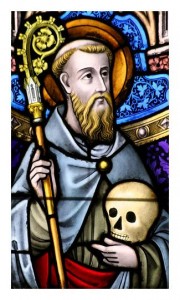 Saint Odilo of Cluny (962-1049) is remembered for his intense Benedictine life at Cluny and as the 5th abbot of Cluny he oversaw the expansion of the Cluniac reform but he’s best remembered for his concern for he poor souls in purgatory. There is some debate if he was the 5th or the 3rd abbot of Cluny. However, Odilo’s importance lies in the fact that he instituted the commemoration of All Souls (c. 1030) as a yearly liturgical remembrance. The Church from the earliest days prayed for the dead with some regularity. Theologically he had a significant interest in the Incarnation.
Saint Odilo of Cluny (962-1049) is remembered for his intense Benedictine life at Cluny and as the 5th abbot of Cluny he oversaw the expansion of the Cluniac reform but he’s best remembered for his concern for he poor souls in purgatory. There is some debate if he was the 5th or the 3rd abbot of Cluny. However, Odilo’s importance lies in the fact that he instituted the commemoration of All Souls (c. 1030) as a yearly liturgical remembrance. The Church from the earliest days prayed for the dead with some regularity. Theologically he had a significant interest in the Incarnation.
Hence two things of Christian life had Saint Odilo’s attention: the care of the poor and the souls of the dead. Of the latter concern also impacted the prior –he decreed that Mass be offered and a monetary offering be made for the poor. He made almsgiving connect with fasting and prayer for the dead: it is not only a lenten piece of Christian spirituality but something that gives a renewed flavor to living the gospel. Odilo instructed that the offering of food given to twelve poor people (as much food as the monks would eat at the main meal).
Regarding the monastic life, Abbot Odilo showed great solicitude for the observance of the monastic life by visiting the monasteries under his guidance on a regular basis. The monasteries following the Rule of Cluny really formed these Benedictines into an “order” because of a centralized authority system and the appointment of superiors in the priories (versus the typical election of a superior found in Benedictinism). Thus, he ensured that decadence that has a habit of creeping into a monk’s life was averted.
Saint Odilo has several possible dates for his liturgical memorial: January 1, 2, or 3; 19 at Cluny; April 29 as part of the feast of the Seven Abbots of Cluny and February 6 in Switzerland. Take your pick. But I think, generally, Odilo’s liturgical memorial is bridged with under the title of “Abbots of Cluny” on April 29.
The antiphon “Odilo showed wondrously what was the charity of his heart, who, while pitying sufferings of the faithful departed, yearly decreased them by a sweet refreshment, alleluia.”
Baldwin of Ford
In 1190 the Cistercian monk and Archbishop of Canterbury Baldwin of Ford died in Tyre, Lebanon.
Baldwin was born around the year 1120 in Devonshire, England. After completing his studies, perhaps at Exeter, he began a successful career in the service of Pope Eugenius III, who had begun his spiritual life as a Cistercian monk.
Upon returning to England, in 1169 Baldwin left all else behind and became a monk at the Cistercian abbey of Ford. He was soon made abbot, and although he did not spend many years in the monastery, he understood that monastic life is essentially a search for communion. In his beautiful treatises on community life, Baldwin was the first to assert that every human form of communion, especially in a monastic community, descends from the shared life of the three Persons of the Trinity.
Baldwin was elected bishop of Worcester in 1181, and several years later he became Archbishop of Canterbury. As leader of the Church of England, he was forced against his will to enter the turmoil of politics. During the reign of Henry II, who was responsible for the death of Thomas Becket, Baldwin defended the memory of his predecessor at Canterbury in his preaching and writing. He met his death participating in the third crusade at the orders of the new king, Richard the Lionheart.
From the Martyrology of the Monastery of Bose, Italy
Blessed Columba Marmion
 If you ask monks and priests of an older generation about today’s Blessed, you will likely hear that he was a spiritual master and a man faithful to his vocation and the venerable theological teaching of the Church. You will hear people say that “Marmion is still alive and well and doing great things for people.” And in a certain real sense he is very alive with a new mission given to him by the Trinity. I “met” Dom Columba through friendship with a monk and also at the Illinois monastery named to honor him.
If you ask monks and priests of an older generation about today’s Blessed, you will likely hear that he was a spiritual master and a man faithful to his vocation and the venerable theological teaching of the Church. You will hear people say that “Marmion is still alive and well and doing great things for people.” And in a certain real sense he is very alive with a new mission given to him by the Trinity. I “met” Dom Columba through friendship with a monk and also at the Illinois monastery named to honor him.
Dom Columba was abbot of Maredsous Abbey in Belgium. Ordained as a diocesan priest of Dublin, he entered the monastic life when he was 30, and by 28 September 1909 his brother monks elected him their abbot–a monastery of more than a 100 monks at the time; he served in that capacity until his death on January 30, 1923.
Marmion authored three books based upon his extensive retreats. These works give a deep insight into his spirituality: Christ, the Life of the Soul (1917), Christ in His Mysteries (1919), and Christ the Ideal of the Monk (1922). His is a spirituality centered on Christ and our divine adoption as children of God. Translations of these works exist in many languages, and many consider them to be spiritual classics.
Saint John Paul II beatified Abbot Columba as a Blessed of the Church on September 3, 2000, and considered him pivotal in his formation. In fact, among the few personal books in his papal library one found the works of Marmion. It was the Holy Father who told one of his aides: “I owe more to Columba Marmion for initiating me into things spiritual than to any other spiritual writer.”
Franciscan Father Groeschel notes that “Abbot Marmion in some ways was the beginning of a movement that became known, under Popes John Paul II and Benedict XVI, as the ‘New Evangelization.'”
I would like to remember in prayer my monk-friends at Marmion Abbey, Aurora, Illinois.
